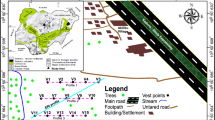Abstract
Present study aims to evaluate the potentiality for the application of rainwater harvesting (RWH) technique through dug well recharge (DWR) system in agro-based drought-prone Barind Tract, NW Bangladesh—the granary. Meteorologically, the climatic condition in the area leads to vulnerability of drought where annual average rainfall amount is about 1300 mm (national average of 2550 mm), but, due to the agricultural practices, huge amount of groundwater is withdrawn for irrigation. The aquifer for large-scale groundwater development exists at greater depth at present. Annual average temperature is 25.93 °C with high average humidity value of 75%. Geophysical survey shows that the top most clay layer of thickness (17 m) of low infiltration capacity is a great barrier for natural groundwater recharge and below top most clay layer sandy aquifer layer of 31 m thickness is considered as potential zone for groundwater development. Groundwater-level (GWL) depletion during the period of 1980–2017 is nearly 9.96 m with an average declining rate of 0.378 m/year. The declining rate of GWL has abruptly increased after 2004. The aquifer is not fully recharged even during rainy season, and the GWL does not reach its original position after 2004. Therefore, groundwater resource is under stress and the situation is worsening due to increasing irrigation demand with extension of command areas. Moreover, temporal variability of precipitation along with the declining trend of GWT is the burning governing factor for RWH system as adaptation strategy. In the present study, an RWH system is operated in the Kakonhat Pourashova of Godagari Upazila through construction of DWR structure where rainwater is harvested from the roofs of Pourashova and auditorium buildings with a catchment area of 692 m2. Here, the amount of water consume by each household is 224 liters per day. The groundwater recharge with RWH technique is operated by the Managed Aquifer Recharge (MAR) technology through dug well (1 m diameter with a depth of 23 m), and includes a recharge box (22 m3) structure filled with sands of different texture act as filter. Considering the run-off coefficient of 0.85 and the annual rainfall of 1300 mm, this DWR structure can harvest 765 m3 of rainwater that can be stored in the aquifer for further use. Otherwise, if this amount of rainwater is not harvested in this way, this would be lost as evaporation due to high temperature and low infiltration capacity of soil, or flowing as run-off water into streams and ultimately to rivers. The research findings presented in this paper could be applied in areas with similar socio-economic status and climatic condition as a novel technique for adaptation measure in drought-prone areas in Bangladesh.













Similar content being viewed by others
References
Adham MI, Jahan CS, Mazumder QH (2010) Study on groundwater recharge potentiality of Barind Tract, Rajshahi District, Bangladesh using GIS and remote sensing technique. J Geol Soc India 75:432–438
Arefin R (2012) Buffer Water management: a viable solution to groundwater depletion in high Barind Area, NW Bangladesh. Unpublished M.Sc. Thesis, Department of Geology and Mining, University of Rajshahi, Bangladesh
BMDA (Barind Multipurpose Development Authority) (2001) Project Performa for the Barind integrated area development project, Phase-II, 4th revision. Barind Multipurpose Development Authority, Rajshahi
Ghisi E, Montibeller A, Schmidt RW (2006) Potential for potable water savings by using rainwater: an analysis over 62 cities in Southern Brazil. Build Environ 41(2):204–210
IPCC (2007) Impacts, adaptation and vulnerability. In: Parry ML, Canziani OF, Palutikof JP, van der Linden PJ, Hanson CE (eds) Contribution of Working Group II to the Fourth assessment report of the intergovernmental panel on climate change. Cambridge University Press, Cambridge, pp 469–506
IRRI (International Rice Research Institute) (2010) World rice statistics (WRS), Manila, Philippines
Jahan CS (1997) Origin of groundwater and prospective of its utilization in Barind area, Bangladesh. Unpublished PhD Thesis, Moscow State Geological Prospecting Academy, Russia
Jahan CS, Rahman ATMS, Mazumder QH, Kamruzzaman M (2015a) Sustainable groundwater resource management through MAR Technique under changing climate in drought prone Barind Tract, rural Bangladesh, 42nd IAH Congress (IAH 2015), Rome, Italy, Held on 13–18 September, 2015
Jahan CS, Rahman ATMS, Mazumder QH, Kamruzzaman M (2015b) Sustainable groundwater resource management through MAR Technique under changing climate in drought prone Barind Tract, rural Bangladesh, Bangladesh: Combating Land Degradation and Drought Series-II, Department of Environment, Ministry of Environment and Forestry, Bangladesh, pp 61–83, ISBN 978-984-33-9991-5
Jury WA, Vaux HJ (2005) The role of science in solving the world’s emerging water problems. Proc Natl Acad Sci USA 102(84):15715–15720
Kuczera G (2007) Regional impacts of roof water harvesting- supplementing public water supply. Paper presented at the rainwater colloquium in Kuala Lumpur, Malaysia
Murad AA, Al Nuaimi H, Al Hammadi M (2007) Comprehensive assessment of water resources in the United Arab Emirates (UEA). Water Resour Manag 21:1449–1460. https://doi.org/10.1007/s11269-006-9093-4
O’Hara JK, Georgakakos KP (2008) Quantify the urban water supply impacts of climate change. Water Resour Manag 22:1477–1497. https://doi.org/10.1007/s11269-008-9238-8
Pitman GTK (1981) Aquifer and recharges evaluation in Bangladesh, Technical Note No.8 UNDP/UNDTCD Groundwater Survey, BGD/74/009, BWDB, GWC
Scott CA, Sharma B (2009) Energy supply and the expansion of groundwater irrigation in the Indus-Ganges Basin. Int J River Basin Manag 7:1–6
Siegert K (1994) Introduction to water harvesting; some basic principles for planning, design and monitoring proceedings of the FAO Expert Consultation, Cairo
Thomas TH, Martinson DB (2007) Roof water harvesting: a handbook for practitioners, Technical paper series, no 49. IRC International Water and Sanitation Center Delft, The Netherlands, 160p
Wheida E, Verhoeven R (2007) An alternative solution of the water shortage problem in Libya. Water Resour Manag 21:961–982. https://doi.org/10.1007/s11269-006-9067-6
Author information
Authors and Affiliations
Corresponding author
Additional information
Publisher’s Note
Springer Nature remains neutral with regard to jurisdictional claims in published maps and institutional affiliations.
Rights and permissions
About this article
Cite this article
Rahaman, M.F., Jahan, C.S. & Mazumder, Q.H. Rainwater harvesting to alleviate water scarcity in drought-prone Barind Tract, NW, Bangladesh: a case study. Sustain. Water Resour. Manag. 5, 1567–1578 (2019). https://doi.org/10.1007/s40899-019-00311-8
Received:
Accepted:
Published:
Issue Date:
DOI: https://doi.org/10.1007/s40899-019-00311-8




